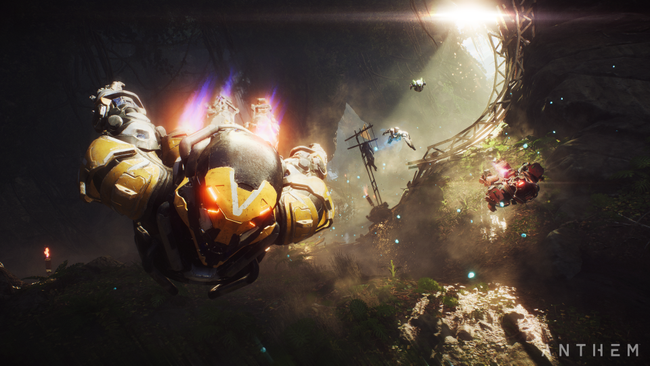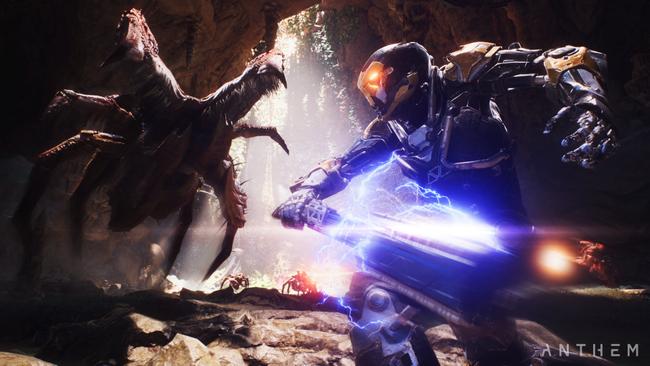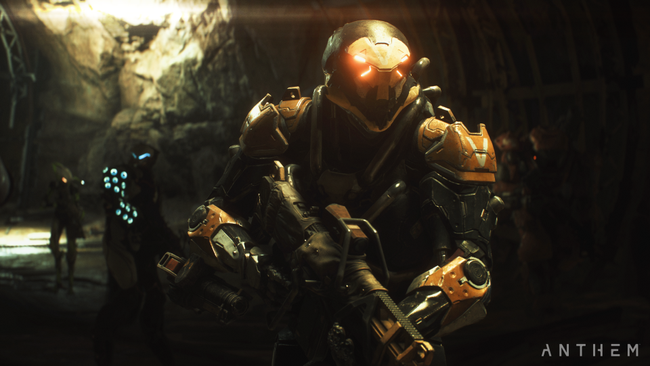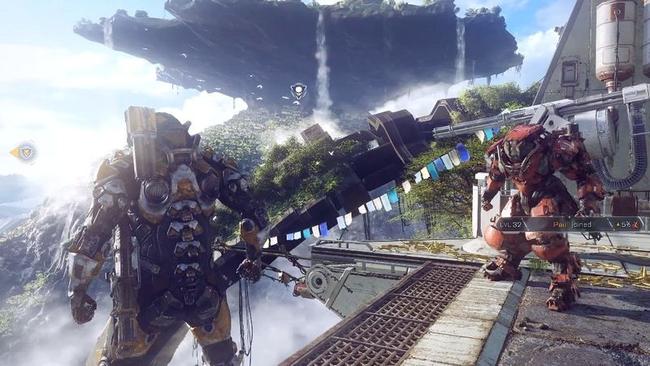
Anthem’s progression system and itemization leave a lot to be desired
With the killing blow dealt, Baal finally collapsed, consciousness fading from his visage as a peculiar mallet skittered across the floor and away from the demon’s clutches. The legendary Schaefer's Hammer now lay at our hero’s feet, their elation imbuing the crypt with a radiance brighter than any torch. The hellish beasts were slain, worlds were reshaped, and a crappy cable modem’s propensity to disconnect from Battle Net at inopportune times had endured; yes indeed, all the trials were worth it.
By the by, that was my adolescent brain’s retelling of finding a rare hammer in Diablo 2. It’s romanticized and extra, but what can I say? The occasion was exhilarating. For me, this was as momentous an occasion as when Link first wielded the Master Sword, despite the fact that my story was more akin to pulling a slot machine’s lever, and that I just so happened to win big. If you play Destiny or any action RPG with an emphasis on randomized item drops, there’s no doubt that you’ll have similar tales.
These are the kinds of stories that Bioware wants players around Anthem’s campfire. Tales of adventurers hunting treasure, overcoming insurmountable odds, and reaping the rewards. The trouble is, the studio’s latest release has several glaring problems with how it handles loot, and that’s a disconcerting dilemma to have in a game that’s centered entirely around acquiring as many magical space guns as possible.

Anthem’s gear progression system is full of awkward design choices that impede any desire to invest fully in its loop. Here’s the gist: begin an expedition, fly to a location, trigger wave-based combat events, pop lobster-people in the head, collect geometric shapes from the fallen crustaceans, listen out for the horn sound marking the completion of the expedition, then teleport back to a rewards screen for the goods. Loot is represented by rhombus-shaped doodads for some reason and there’s no way to know what you’ve found until after the expedition has concluded. At glance, it’s a bog-standard rhythm for this sort of game. Spend more time with it though, and you’re bound to notice why the progression system will fill most ARPG-loot enthusiasts with trepidation.
Progression in Anthem is precariously similar to waiting in a cafeteria lunch line. The “Expedition Complete” notification buzzes would-be Freelancers up to the front of the line where they scramble to find loose rhombi in their pockets to place on the counter. Then, and only then, is loot slopped onto your plate. Repeat this ad nauseam. There’s no mid-expedition intrigue over what plunder might be in a chest, no jubilation over a cool weapon dropped by an enemy, and no immediate satisfaction upon equipping a new find; you’ll never actually find items out in the world. You just finish the mission and enjoy some rhombi-slop when your number is called.
Distributing loot in this fashion undermines the treasure-hunting component typically found in loot shooters. Nobody wants to comb the ground after a battle for geometric shapes in the hope they might turn out to be something cool later. After all, there’s a layer of tedium in involved in any gear grind no matter how good the game is. That’s not a problem unique to Anthem, it’s just part of the genre. However, this can be rectified by… actually letting you find and recognize loot out in the world.

Think of Diablo 3’s adventure mode. Everyone loves it, right? That’s because you can walk 10 steps and get a flaming-hydra-sword or you could play for hours and find jack shit. In any regard, we’re at the mercy of RNG. It can be brutal, but it serves a greater purpose; nervous anticipation accompanies every monster killed because a piece of cool loot could drop at any moment.
Diablo 3’s adventure mode hooks players because there’s always a chance, no matter how minuscule, that you’ll get something awesome and you’ll be able to equip it right away. It’s instant gratification. Why would someone endlessly grind in Anthem’s overworld when there’s so little to mark progression? That purple rhombus in your inventory might be a piece of junk for all you know, the only way to find out is to face the greatest foe of them all: the loading screens.
There’s no doubt that Bioware knows what makes a game like Diablo work; they’ve been developing some of the finest RPGs for two decades now. I’m not trying to present some expert analysis on a subgenre like a know-it-all dork when I’m not a game designer. Thing is, I’m actually certain that loot is distributed the way it is due to technical limitations. In Anthem, loot can only be equipped at the Forge. In order to get there, you’re smacked with a loading screen.

In theory, if you could find loot and wanted to equip it mid-expedition, you’d first have to load into the forge before being met with another loading screen upon exiting. Yes, that’s two loading screens just to view and exit the inventory menu. This would bring expedition pacing to a screeching halt, so only giving out loot in a specific screen seems like a decent way to mitigate the issue. However, if it was BioWare’s great solution, then it appears to have come at the expense of other aspects of the game and highlighted the other fundamental flaws present in Anthem.
Oh, and I haven’t talked about how the vast majority of the loot is about as interesting as a two-year-old recapping their day yet, eh? A huge pet peeve of mine with loot-centric RPGs is gear updates that only add stats with no unique modifiers. It’s boring. Sure, bigger damage numbers flooding the screen make for a good endorphin rush, but when that’s all the loot offers then upgrading equipment quickly loses its intrigue. For Anthem’s first 30 levels, stat upgrades are all the loot has to offer. Item rarities found sub-30 are fairly typical: common (white), uncommon (green), rare (blue) and epic (purple).
No matter the color shade though, the upgrades are the same: stats, some arbitrary secondary improvement on a damage type, and that’s it. A blue shotgun isn’t any more exciting to wield than a white shotgun because the functionality is exactly the game, you just hit harder. What’s particularly baffling about this is that Anthem doesn’t even have a stats page for your character. So if a machine gun increases your damage, you don’t even know what the base statistic you’re working with is aside from the weapon’s core numbers. The worst part about this is that Anthem actually does have gear with more meaningful unique modifiers, but the catch is that they’re hidden away in the endgame.

It’s common practice in online RPGs to stick the best loot behind a steep progression gate in the post-game. Usually, it’s a significant time investment with plenty of tedium, but hey, this is content for the most dedicated players. The best loot is their reward for sticking with the game through thick and thin. Anthem, on the other hand, opts for a gargantuan progression gate about halfway through its story campaign. One that will have you pining for even the slightest hint of variety by before all is said and done.
The Tombs of the Legionnaires is an already infamous quest grind found about halfway through Anthem’s campaign. Each tomb is comprised of thrilling content such as: killing enemies with melee attacks, finding random treasure chests, or harvest gathering nodes. Yes, the mythical freelancers: monster slayers, rescuers of the lost, and the ones silencing the world’s terrible cataclysms; they’re best on flower picking duty. Now, gating like this isn’t a problem in and of itself, this is hardly the first game to do so. The problem is the point it comes in the game.
Most players are still lugging around green and blue items, which is to say combat is still painfully vanilla. The grind would be at least a smidge better with late game items adding some modifiers. Not to mention people should hardly be encountering a hard progression gate in the middle of the story. Plenty of players will be drawn to Anthem because they’re familiar with Bioware’s previous works like Mass Effect. Maybe it’s their first online loot action RPG like this and they’re not used to the baggage that comes with the subgenre.

So why Bioware opted for this is beyond me, because as it stands right now the tombs only serve as a deterrent. Final Fantasy XIV is loaded with long grinds and hard gating at points, but the storyline is never hidden behind the game’s more difficult time investments. A casual player will have to do a simple dungeon or trial at worst because story content is also a means of easing players into the intricacies of an MMORPG. Not to say Anthem has to take the exact same approach, but saving the progression gating for the endgame is probably the best way to ensure people actually complete the campaign and continue playing afterward.
The masterwork and legendary gear tiers both add modifiers that greatly mix up how combat plays out. You might find a weapon that dramatically increases damage while aerial, encouraging freelancers to hover above the battle as much as possible. Another weapon might have a hit chance to significantly increase melee damage for a time, coaxing freelancers to run up and punch lobster-people right their slimy mandibles. Those modifiers add so much to a combat system that’s otherwise fairly dull. Which is why I have no idea why they’re tucked away until the very end. True, it’s debatable these games don’t truly start until end-game progression, but the first 20-30 hours would less of a struggle if you had gear modifiers that accentuated the best parts of the combat system instead of just increasing your ammo capacity by 2%.
What hurts most about these shortcomings is how Anthem has so much potential for an interesting progression system. Unfortunately, every creative step forward is accompanied by three steps back. Levels are wildly vertical, and I can’t help but salivate over the idea of Guild Wars 2-style jumping puzzles, but with your javelin’s jetpack. Imagine carefully timing the leap over a cavernous ravine as your jetpack is running on fumes. It’s scary, but remember, you’re a Freelancer and danger comes with the job, Icarus ain’t got shit on you. That’s when you touch down on the other side, a chest full of great loot marking such your tremendous accomplishment.

In Anthem’s current state, though, that chest would just be full of geometric shapes, and the shapes would turn into guns that just increased your damage a little. The jump itself doesn’t exist because exploration is just wandering around from world event to reputation grind, participating in boring waves of incoming lobster-people and outlaws. There’s probably a network disconnect in there too, so get ready for several loading screens before getting back to those hard progression gates.
Everything about Anthem is accompanied with an exasperated sigh, and Bioware wants us to endure it all for loot. That’s quite a gamble, to hope that the loot, itemization, and character progression will make players overlook the myriad of problems that the game has. By contrast, Diablo 2, the granddaddy of loot-centric action RPGs, was held up entirely but its itemization and loot.
Every class had approximately one attack they’d spam, but it was no big deal because gear modifiers altered how those attacks functioned. Items were the vehicle by which the game brought variety to combat and spiced up the endless grind. That hammer I mentioned earlier drastically increased attack speed and added a chance for lightning coils to burst forth from my character. Suddenly, my Paladin became a lightning-enchanted, whack-a-mole murderball, and it was as hilarious as it was satisfying. At no moment was I excited over item drops in Anthem because the game doesn’t allow for Schaefer's Hammer-moments. There are just boring activities where boring loot is dispersed in the most boring way possible.
If the likes of Final Fantasy XIV or Diablo 3 have taught us anything, it’s that every game has a shot at redemption. Bioware has brought enough good ideas to the table with this game that can be salvaged and repurposed later on. Maybe Anthem: The Reaper of a Forsaken Realm Reborn will have a progression system full of interesting loot found in its world, but only time will tell if an update on that scale will ever materialize.